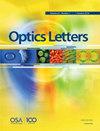系统不确定度为7.8×10-15的激光冷却171Yb+微波时钟。
IF 3.3
2区 物理与天体物理
Q2 OPTICS
引用次数: 0
摘要
我们提出了一种基于171Yb+基态超精细分裂的可移动激光冷却离子微波时钟。系统的系统不确定度为7.8×10-15,短期频率稳定性为9.5×10-13/τ。磁场系统的增强抑制了多体离子系综中的退相干过程,并将二阶塞曼频移降低了两倍。测量到的绝对微波频率为12 642 812 118.468 6(3)Hz,与之前的测量结果一致,并且显示出当前最先进技术的两倍精度。本文章由计算机程序翻译,如有差异,请以英文原文为准。
Laser-cooled 171Yb+ microwave clock with a systematic uncertainty of 7.8×10-15.
We present a transportable laser-cooled ion microwave clock based on the ground-state hyperfine splitting of 171Yb+. The system achieves a systematic uncertainty of 7.8×10-15 and a short-term frequency stability of 9.5×10-13/τ. Enhancements to the magnetic-field system suppress the decoherence process in the multi-body ion ensemble and reduce the second-order Zeeman frequency shift by a factor of two. The absolute microwave frequency is measured to be 12 642 812 118.468 6(3) Hz, consistent with the previous measurements and demonstrating twice the precision of the current state-of-the-art.
求助全文
通过发布文献求助,成功后即可免费获取论文全文。
去求助
来源期刊

Optics letters
物理-光学
CiteScore
6.60
自引率
8.30%
发文量
2275
审稿时长
1.7 months
期刊介绍:
The Optical Society (OSA) publishes high-quality, peer-reviewed articles in its portfolio of journals, which serve the full breadth of the optics and photonics community.
Optics Letters offers rapid dissemination of new results in all areas of optics with short, original, peer-reviewed communications. Optics Letters covers the latest research in optical science, including optical measurements, optical components and devices, atmospheric optics, biomedical optics, Fourier optics, integrated optics, optical processing, optoelectronics, lasers, nonlinear optics, optical storage and holography, optical coherence, polarization, quantum electronics, ultrafast optical phenomena, photonic crystals, and fiber optics. Criteria used in determining acceptability of contributions include newsworthiness to a substantial part of the optics community and the effect of rapid publication on the research of others. This journal, published twice each month, is where readers look for the latest discoveries in optics.
 求助内容:
求助内容: 应助结果提醒方式:
应助结果提醒方式:


